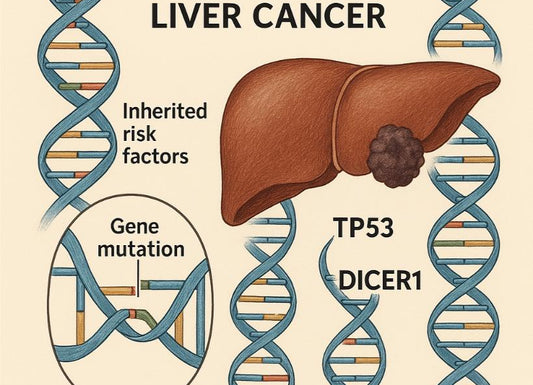What Are the Signs That Pancreatic Cancer Has Spread to Liver?
 Written By
Jaclyn P. Leyson-Azuela, RMT, MD, MPH
Written By
Jaclyn P. Leyson-Azuela, RMT, MD, MPH

Pancreatic cancer, when in an advanced stage, spreads to other organs, with the liver being the most common distant site of metastasis. There are specific signs that pancreatic cancer has spread to liver. These signs appear because liver function becomes more impaired as cancer cells grow uncontrollably. It is important to recognize these signs early on to help patients get timely treatment and help them manage their symptoms effectively.
Key Takeaways
-
Jaundice, the yellow discoloration of the skin and eyes, and produces dark urine, is present in 50-80% of patients with liver metastasis from pancreatic cancer.
-
MRI scans can detect about 90% of liver metastasis and are 30% more sensitive than CT-scan when looking for smaller lesions.
-
The 5-year survival rate for pancreatic cancer that has reached distant sites like the liver is around 3.2%.
-
Treatments focus more on symptom management and ensuring quality of life through chemotherapy, targeted therapies, and most especially palliative care.
-
Bile duct stenting is a method that effectively relieves symptoms of jaundice, which allows bile to flow normally when the tumor is blocking the ducts.
When pancreatic cancer begins to grow, it doesn’t automatically spread to other parts of the body. The time when it goes to other organs is usually when it is in its advanced stage, which is called metastasis. Over 50% of people with pancreatic cancer will have liver metastases at the time that it is diagnosed and often this signifies poor prognosis.
What are the common symptoms when pancreatic cancer spreads to the liver?

Pancreatic cancer that spreads to the liver produces many different symptoms. These symptoms occur because the liver is either impaired and cannot do its usual job well or the tumor is pushing on other tissues. Here are the main symptoms you need to watch out for:
What is jaundice and how does it relate to pancreatic cancer spreading to the liver?
Jaundice (the yellowish discoloration of skin and eyes) is one of the most common symptoms that pancreatic cancer has spread to the liver. It results from the build up of a substance called bilirubin in the body.
Bilirubin is a yellow substance that forms when old red blood cells are broken down. The liver processes this substance and sends it to the intestines through the bile ducts.
When liver metastasis occurs, it can block the bile ducts or destroy liver tissues. Bilirubin can’t flow normally in these instances, which results in its buildup in tissues and in the blood. Signs of jaundice include:
-
Yellow discoloration of the skin and whites of the eyes
-
Dark-colored urine (cola- or tea-colored urine)
-
Light-colored or clay-colored stools
-
Itchiness of the skin all over the body
Jaundice may occur early if the tumor is located at the head of the pancreas. It is because tumors in this location can block the flow of bile early in its stage. About 50% of people with pancreatic cancer present with jaundice at some point in the disease.
Other symptoms that might indicate liver metastasis

There are several other signs that pancreatic cancer has spread to liver, including:
-
Abdominal pain, particularly at the right part. This occurs when the liver gets bigger (hepatomegaly) or when the tumor pushes on the liver’s covering or nearby tissues. The pain is felt as dull and achy in nature.
-
Accumulation of abdominal fluid (ascites), which is a direct result of liver dysfunction or when cancer cells irritate the lining of the abdominal tissues. The belly will get bigger as the fluid accumulates, which is measured through abdominal girth.
-
Fatigue or extreme tiredness. The body uses a lot of energy as it tries to fight cancer. The liver, which primarily stores energy, may not be able to help in producing the required calorie as well as it should. This results in extreme tiredness or fatigue.
-
Weight loss. As cancer cells eat up the body’s energy and as the liver continues to get destroyed, the body will have a hard time digesting food and using nutrients. This results in profound loss of weight.
-
Feeling full. Liver problems can make you feel full or not be able to feel hungry.
-
Vomiting. Liver problems due to metastases make you feel sick to your stomach that makes you throw up anything that you eat. This may occur when the liver cannot detoxify anymore and there is buildup of toxins in the blood.
-
Bleeding and easily bruising. One of the liver’s functions is to make proteins responsible for clotting blood. When it is not working properly, it manifests as easily bruising and bleeding.
Diagnosis of Liver Metastasis in Pancreatic Cancer
Finding out if pancreatic cancer has spread to the liver takes several steps. Doctors often use a mix of medical history, physical exam, imaging tests, and other times biopsy.
Imaging tests that are used to detect liver metastasis from pancreatic cancer

There are several different imaging tests that can be used if pancreatic cancer has spread to the liver, including:
-
CT-Scan (computed tomography scan). This is often the first imaging test requested. A CT-scan takes many different images from several angles to make detailed images of body tissues, including the liver. To ensure good results, a special dye may be used called a contrast that will be injected through a vein before the imaging test. This dye helps in visualizing the tumors better. CT scan detects about 77% of liver metastasis.
-
MRI (magnetic resonance imaging). MRI uses strong magnetic fields and radio waves to create images of the body. It is good in detecting small liver metastasis that CT-scans may miss. According to the World Journal of Gastroenterology, MRI permits a conclusive diagnosis in 95% of liver lesions. However, this imaging takes longer to complete than CT-scan and it may not be ideal for people with claustrophobia (those with fear of enclosed spaces).
-
Ultrasound. The test uses sound waves to visualize organs in the body. It is often the first line imaging used to detect liver lesions along with CT and MRI. It is quick, doesn’t use radiation, and generally costs less than other imaging techniques. However, ultrasound isn’t as good at detecting liver metastasis as the other modalities because liver metastasis takes several appearances that generalization may be difficult to make.
-
PET Scan (positron emission tomography). This type of imaging technique uses a small amount of radioactive material injected into the vein (usually sugar). Cancer cells take up more sugar than normal cells, so they tend to show brighter in a PET scan. It helps detect cancer metastasis to other parts of the body including the liver. However, it is not always necessary if CT or MRI has proven conclusively that metastasis has indeed occurred.
What role does biopsy play in confirming liver metastasis?
A biopsy is done when doctors take a small sample of tissue and visualize it under a microscope. It is a definitive diagnostic test of liver metastasis, particularly when imaging tests remain inconclusive. There are several ways to do liver biopsy, including:
-
Fine-needle aspiration (FNA). This is a common approach where doctors use a fine needle to take a small sample of cells from the liver. It is often guided by ultrasound or CT to make sure that the needle has hit the right spot.
-
Core needle biopsy. This approach uses a slightly bigger needle to take a sample tissue, not just cells. It gives more information about cancer than the FNA.
Doctors don’t necessarily need a biopsy if the imaging tests clearly show that pancreatic cancer has spread to the liver. It is especially true if they know for certain that the patient has pancreatic cancer in the first place. But a biopsy can help in confirming the diagnosis and even provide more information that can guide the doctors in their treatment plan.
But, biopsies also pose some risks like infection or bleeding where the needles are inserted. This is important to consider especially if the patient may already have a deranged blood clotting mechanism because of liver metastasis. Nonetheless, these issues are rare and the benefits clearly outweigh the risk.
What laboratory tests are used in monitoring pancreatic cancer with liver metastasis?
Blood tests play a big role in checking how the liver is doing and monitoring the cancer’s activity. Doctors use these tests to help in the management planning and to monitor how well the treatments are working.
How do liver function tests help in detecting liver involvement?

Liver function tests (LFTs) are a type of blood test that show how well the liver is working. When pancreatic cancer has spread to the liver, these tests often show abnormal results. The main tests include the following:
-
Bilirubin level. This measures the amount of bilirubin in the blood. Tests often measure the direct (conjugated) bilirubin and total bilirubin with normal results as follows:
-
Direct bilirubin: less than 0.3 mg/dL
-
Total bilirubin: 0.1 to 1.2 mg/dL
High bilirubin results in jaundice and may mean that the bile ducts are obstructed or the liver has been significantly damaged.
-
Alkaline phosphatase (ALP). This is an enzyme that is found in the liver. It normally falls between the range of 44 and 147 IU/L. There are several reasons why ALP increases, including obstruction of the bile ducts or liver issues, which can be both results of liver metastasis.
-
Alanine aminotransferase (ALT) and aspartate aminotransferase (AST). These two enzymes are mainly found in the liver, with high levels often indicating that the liver is damaged. Normal levels are as follows:
-
Albumin. This is a protein made by the liver with normal levels that falls within the range of 3.5-5.5 g/dL. If the level falls below normal, it usually means that the liver is not working properly.
-
Prothrombin Time (PT). This test measures how quickly the blood forms clots. The liver makes proteins that help in blood clotting. So, if the liver is damaged or not working well, it will take longer for blood to clot. Normal range of prothrombin time generally falls from 11 to 13.5 seconds.
It is important to note that abnormal LFTs don’t always mean the cancer has spread to the liver. There are other things that may cause abnormal results, such as medications, chronic alcohol use, and other liver diseases. But if you are diagnosed with pancreatic cancer and LFT results are getting worse, it may signify that cancer is already affecting the liver.
What is the significance of tumor markers like CA 19-9 in liver metastasis?
Tumor markers are substances that are found in the blood, other body fluids, or tissues when cancer is present. CA 19-9 is the most common tumor marker for pancreatic cancer. It is elevated in patients with symptomatic pancreatic cancer in about 80% of cases. The marker can be used to:
-
Help monitor how the cancer is responding to treatment
-
Check whether the cancer is growing or spreading
-
Look for signs that cancer has recurred after successful treatment
Normal level of CA 19-9 is less than 37 U/mL and abnormally high levels could indicate that the cancer is getting worse by growing or spreading. But you have to know that CA 19-9 isn’t specific to liver metastasis, which means its levels could be high even when the cancer has not yet spread to the liver. There are also patients who don’t get high levels of this tumor marker even when they have already been diagnosed with pancreatic cancer.
Conditions that may produce high levels of CA 19-9 include: pancreatitis, primary liver diseases, and other digestive system issues.
Doctors don’t usually use CA 19-9 as a marker alone to diagnose pancreatic cancer or to see whether the tumor has spread to distant organs. It is usually used alongside imaging tests and other information to get a better picture of the disease.
How does the presence of liver metastasis affect the prognosis of pancreatic cancer?
The metastasis of pancreatic cancer to the liver is a serious complication that affects the overall outlook (prognosis) for the patients. When pancreatic cancer has spread, particularly in the liver, it is classified as stage IV.
According to the Surveillance, Epidemiology, and End Results (SEER) program of the National Cancer Institute, the 5-year survival rate for people with metastatic pancreatic cancer is roughly around 3.2%. This is much lower than when the cancer has not yet spread at 51%.
But it is important to remember that statistics like these are based on a large study population and can’t predict what will happen to one patient. There are several factors that could also affect the 5-year survival rate of patients with pancreatic cancer. This includes:
-
The number and size of metastasis
-
Whether it has spread to other organs apart from the liver
-
The patient’s overall health and ability to perform daily tasks
-
How well the cancer responds to treatment
-
The genetic features of cancer
When pancreatic cancer has already spread in the liver, the efforts in the treatment and management are focused on controlling further tumor growth, managing the symptoms, and improving quality of life.
Curing cancer may not be possible when it has already advanced to stage IV. But while this may be so, many people can still live for months or even years with proper management.
It’s important for patients to have honest conversations with their healthcare team about their prognosis and goals of treatment.
What treatment options are available for pancreatic cancer that has spread to the liver?
Advanced stage treatment often focuses more not on “curing” anymore but on symptom control and improving the patient’s quality of life. Several treatment options are available at this stage:
Chemotherapy
This method of treatment uses strong drugs that kill cancer cells or stop the tumor from growing further. But for pancreatic cancer that has spread to the liver, it is the main treatment to:
-
Shrink tumor size
-
Slow down the cancer’s growth
-
Offer symptomatic relief
-
Possibly extend life
Other Therapies

Apart from chemotherapy, other forms of therapies serve as options for people with pancreatic cancer with liver metastasis. It usually includes:
-
Targeted therapy. The drugs used in this form of treatment target specific genes or proteins that help cancer cells grow. It is ideal for people whose cancer has special genetic changes.
-
Immunotherapy. This form of treatment provides support to the body’s immune system to fight cancer. It may not be as successful for pancreatic cancers as it is in other forms of cancer but research is still ongoing. Some patients may even be eligible in its clinical trials.
-
Radiation therapy. This method uses radiation to kill cancer cells. It is not specifically used for liver metastasis due to pancreatic cancer but it may be helpful in relieving symptoms.
-
Ablative approaches. These approaches are often used to destroy tumors without removing them. Some types include:
-
Radiofrequency ablation
-
Microwave ablation
-
Cryoablation
-
Embolization
The best treatment approach depends on several factors such as the extent of cancer spread, your overall health, and personal preferences. Nonetheless, it is important to talk things over with your healthcare provider so you know what is best for you.
How can symptoms of liver metastasis be managed?
Symptom management is an important part of care for people suffering from pancreatic cancer that has spread in the liver. Good symptom management often leads to increased quality of life despite the fact that they are no longer cured.
How to manage jaundice in patients with liver metastasis?
Jaundice can cause a lot of discomfort and affects the quality of life. There are several ways to manage this condition:
-
Stenting. A method that places a small tube in the duct to keep it open particularly if a tumor is causing an obstruction.
-
Biliary bypass surgery. Surgeons create an alternative path for bile to flow from the liver to the intestine, which bypasses the obstruction.
-
Using medicine for itchiness like antihistamines and cholestyramine
-
Skin care using mild soaps and moisturizers and avoiding hot bath while wearing loose clothing can sometimes help as well
-
Phototherapy. There are some instances where light therapy (a method used in newborns to alleviate jaundice)
These approaches allow the patients to live comfortably in their remaining days.
What Strategies can Help with Pain and Nutritional Challenges?
Pain and nutritional issues are common in patients with liver metastases. Several key strategies can help:
Pain management:
-
Anti-inflammatory
-
Nerve blocks
-
Radiation therapy
-
Traditional and cumulative strategy that can help relieve pain
Nutritional management:
-
Dietary changes like eating small but frequent meals
-
Supplements like pancreatic enzymes
-
High protein diet
-
Feeding tube if unable to swallow independently
-
Anti-nausea medications
-
Dietician expert consultation
Managing ascites
-
Paracentesis. A procedure done to drain the fluid from the abdomen.
-
Diuretics. Medications that remove excess water from the body
-
Low salt diet. Restricts salt, which prevents fluid buildup
Conclusion

The signs that pancreatic cancer has spread to liver can manifest in many different ways. With proper knowledge, the symptoms can be addressed. Various diagnostic approaches have been introduced, which your doctor may request to adequately manage your condition.
Frequently Asked Questions
How soon can pancreatic cancer spread to the liver?
The speed that pancreatic cancer spreads to the liver varies from case to case. Some patients develop liver metastases within months, while there are others who may not experience this for a longer time.
Is jaundice always present when pancreatic cancer spreads to the liver?
No, jaundice is not always present when there is presence of liver metastasis. There are some people who may have liver metastasis without jaundice even though this is the most common presentation.
Can blood tests definitely tell if pancreatic cancer has spread to the liver?
Alone, blood tests cannot definitively and conclusively determine that pancreatic cancer has spread to the liver. Blood tests like LFTs and tumor markers may tell there is liver involvement but will not differentiate it with other underlying liver problems.
Written by Jaclyn P. Leyson-Azuela, RMT, MD, MPH
Jaclyn P. Leyson-Azuela, RMT, MD, MPH, is a licensed General Practitioner and Public Health Expert. She currently serves as a physician in private practice, combining clinical care with her passion for preventive health and community wellness.
References:
-
ALT. (n.d.). Ucsfhealth.org. https://www.ucsfhealth.org/medical-tests/alanine-transaminase-(alt)-blood-test
-
Azizaddini, S., & Mani, N. (2021). Liver Imaging. PubMed; StatPearls Publishing. https://www.ncbi.nlm.nih.gov/books/NBK557460/
-
Ballehaninna, U. K., & Chamberlain, R. S. (2011). Serum CA 19-9 as a Biomarker for Pancreatic Cancer—A Comprehensive Review. Indian Journal of Surgical Oncology, 2(2), 88–100. https://doi.org/10.1007/s13193-011-0042-1
-
Cleveland Clinic. (2022). Albumin Blood Test: What It Is, Purpose, Procedure & Results. Cleveland Clinic. https://my.clevelandclinic.org/health/diagnostics/22390-albumin-blood-test
-
Freitas, P. S., Janicas, C., Veiga, J., Matos, A. P., Herédia, V., & Ramalho, M. (2021). Imaging evaluation of the liver in oncology patients: a comparison of techniques. World Journal of Hepatology, 13(12), 1936–1955. https://doi.org/10.4254/wjh.v13.i12.1936
-
Gaillard, F. (n.d.). Hepatic metastases | Radiology Reference Article | Radiopaedia.org. Radiopaedia. https://radiopaedia.org/articles/hepatic-metastases-1
-
Immunotherapy for Pancreatic Cancer. (n.d.). Www.cancer.org. https://www.cancer.org/cancer/types/pancreatic-cancer/treating/immunotherapy.html
-
Liver Metastases Diagnosis & Staging | Memorial Sloan Kettering Cancer Center. (n.d.). Www.mskcc.org. https://www.mskcc.org/cancer-care/types/liver-metastases/diagnosis-staging
-
Maino, C., Federica Vernuccio, Cannella, R., Cortese, F., Paolo Niccolò Franco, Gaetani, C., Giannini, V., Riccardo Inchingolo, Ippolito, D., Defeudis, A., Pilato, G., Davide Tore, Faletti, R., & Gatti, M. (2023). Liver metastases: The role of magnetic resonance imaging. World Journal of Gastroenterology, 29(36), 5180–5197. https://doi.org/10.3748/wjg.v29.i36.5180
-
McGahan, J. P., Bishop, J., Webb, J., Howell, L., Torok, N., Lamba, R., & Corwin, M. T. (2013). Role of FNA and Core Biopsy of Primary and Metastatic Liver Disease. International Journal of Hepatology, 2013, 174103. https://doi.org/10.1155/2013/174103
-
MedlinePlus. (2013). Prothrombin time (PT): MedlinePlus Medical Encyclopedia. Medlineplus.gov. https://medlineplus.gov/ency/article/003652.htm
-
Mount Sinai. (n.d.). Aspartate aminotransferase (AST) blood test Information | Mount Sinai - New York. Mount Sinai Health System. https://www.mountsinai.org/health-library/tests/aspartate-aminotransferase-ast-blood-test
-
Mount Sinai. (2024). Bilirubin blood test Information | Mount Sinai - New York. Mount Sinai Health System. https://www.mountsinai.org/health-library/tests/bilirubin-blood-test
-
National Cancer Institute. (2018). Cancer of the Pancreas - Cancer Stat Facts. SEER; National Cancer Institute. https://seer.cancer.gov/statfacts/html/pancreas.html
-
Ouyang, H., Wang, P., Meng, Z., Chen, Z., Yu, E., Jin, H., Chang, D. Z., Liao, Z., Cohen, L., & Liu, L. (2011). Multimodality Treatment of Pancreatic Cancer With Liver Metastases Using Chemotherapy, Radiation Therapy, and/or Chinese Herbal Medicine. Pancreas, 40(1), 120–125. https://doi.org/10.1097/mpa.0b013e3181e6e398
-
Wu, L., Zhu, L., Xu, K., Zhou, S., Zhou, Y., Zhang, T., Hang, J., & Zee, B. C.-Y. (2021). Clinical significance of site-specific metastases in pancreatic cancer: a study based on both clinical trial and real-world data. Journal of Cancer, 12(6), 1715–1721. https://doi.org/10.7150/jca.50317

Jaclyn P. Leyson-Azuela, RMT, MD, MPH, is a licensed General Practitioner and Public Health Expert. She currently serves as a physician in private practice, combining clinical care with her passion for preventive health and community wellness.



